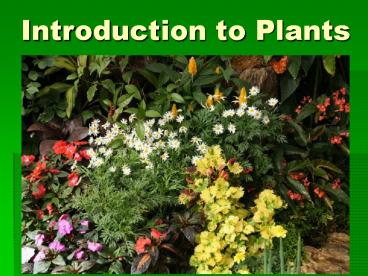Introduction to Plants - PowerPoint PPT Presentation
1 / 18
Title:
Introduction to Plants
Description:
Introduction to Plants The First Plants The earliest photosynthetic organisms were plant-like protists. Even today about 70% of photosynthesis occurs in the oceans. – PowerPoint PPT presentation
Number of Views:239
Avg rating:3.0/5.0
Title: Introduction to Plants
1
Introduction to Plants
2
The First Plants
- The earliest photosynthetic organisms were
plant-like protists. - Even today about 70 of photosynthesis occurs in
the oceans.
3
Non-vascular Plants
- The earliest land plants were non-vascular
plants. - Non-vascular plants have no system of vessels to
carry nutrients, water or waste. - These mosses, liverworts, and hornworts evolved
about 500 mya from green algae.
4
Non-vascular Plant Reproduction
- They need a moist surface for gametes to swim
together for reproduction. - Non-vascular plants lack true leaves, roots or
stems. - All water, nutrients and waste move between cells
by osmosis and diffusion. Their growth is
limited.
5
(No Transcript)
6
Plant Adaptations to Land
- The major adaptations to life on land included
- 1. Protection from drying out leaves and stems.
2. A system of vessels to transport water,
nutrients and wastes the roots, stems and
leaves. 3. A system to hold the plant up and
capture energy from light the stem and leaves.
7
Vascular Plants - Ferns
- As plants adapted to land they evolved more
complex structures. - Ferns were the first vascular plants.
- Ferns have vascular tissue or vessels that
transport materials between different parts of
the plant.
8
- Ferns have true roots to anchor them and absorb
water and minerals. - Fern leaves are photosynthetic and absorb gases
from the atmosphere.
9
Plants with Seeds
- Next plants evolved to have seeds, an
evolutionary adaptation to improve reproductive
success. - Seeds allow a plant to reproduce sexually without
needing water for the gametes to swim to each
other.
10
Gymnosperms
- Gymnosperms are plants that produce naked
seeds. - Gymnosperms include all the conifers or pine
trees that produce cones.
11
Angiosperms
- The most recent evolutionary adaptation for
plants was to produce flowers, again to improve
reproductive success. - Angiosperms are flowering plants.
12
Parts of a Flower
13
Monocots and Dicots
- The seeds of angiosperms are protected in the
body of a fruit, which develops from the ovary . - There are two classes of angiosperms - monocots
and dicots. - Monocots have one seed leaf and dicots have two
seed leaves. - There are numerous differences between monocots
and dicots.
14
Compare Seed leaves
- Monocot one Dicot two
15
Compare Veins
- Monocot parallel Dicot network
16
Compare Vascular Bundles
- Monocot scattered Dicot ring pattern
17
Compare Flower Parts
- Monocot threes Dicot 4s or 5s
18
Compare Roots
- Monocot fibrous Dicot tap root































